
by Ria Olivier | Aug 12, 2025 | Announcement, Ecology, Environment, Invasion Biology, Jobs, Marion Island, Mice Eradication, Microbiology, Research
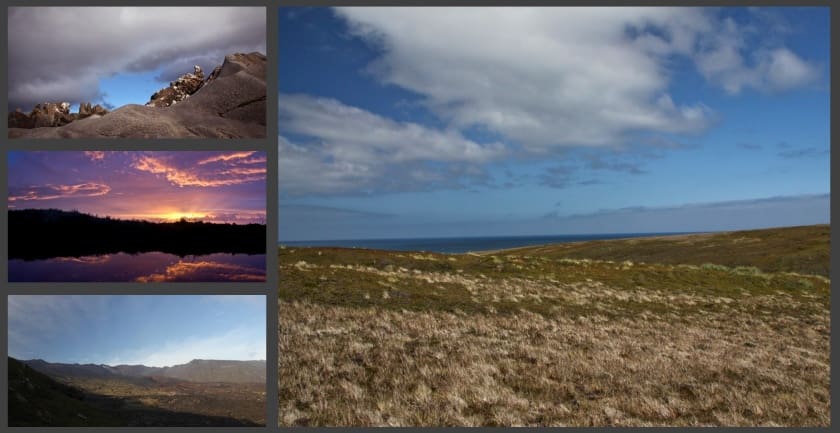 Postdoctoral Fellowship: Understanding Mouse Impacts on Sub-Antarctic Marion Island at Department of Plant and Soil Sciences, University of Pretoria. (image: Otto Whitehead)
Postdoctoral Fellowship: Understanding Mouse Impacts on Sub-Antarctic Marion Island at Department of Plant and Soil Sciences, University of Pretoria. (image: Otto Whitehead)
An exciting postdoctoral fellowship is offered on our South African National Antarctic Programme project “Towards a comprehensive understanding of impacts of the invasive house mouse on the terrestrial biodiversity of Marion Island”. Sub-Antarctic Marion Island is one of the most isolated landmasses globally. The house mouse invaded the island in the early 1800s, and its impacts are manifold, and intensifying under climate change. This project aims to fill gaps in understanding mouse impacts on the island, with the purpose of informing the planned mouse eradication. This position will provide exciting opportunities to work on excellent long-term and/or spatially well-sampled datasets and inform island management.
Full Details and Advertisement
Additionally, opportunities to collaborate locally and internationally exist within this project. We are looking for a candidate with expertise in one or several of the following, or related fields: community ecology, isotope ecology, entomology, botany, trait ecology; or with an ability to learn the necessary skills. Their primary responsibility will be conducting and leading research into one or several of these themes. Opportunities for student supervision and teaching also exist.
Closing Date : 29 August 2025

by Ria Olivier | May 22, 2025 | Antarctica, Biosecurity, Commemorative Days, Gough Island, International Days, Invasion Biology, Marion Island, Prince Edward Islands
 The United Nations has designated May 22 as the International Day for Biological Diversity (IDB), a day to reflect on the vital role biodiversity plays in sustaining life on Earth. The 2025 theme, “Harmony with Nature and Sustainable Development,” underscores the importance of conserving biodiversity to ensure a sustainable future for both people and the planet. It is a timely reminder that a thriving natural world is the foundation of human well-being and a cornerstone for achieving the Sustainable Development Goals.
The United Nations has designated May 22 as the International Day for Biological Diversity (IDB), a day to reflect on the vital role biodiversity plays in sustaining life on Earth. The 2025 theme, “Harmony with Nature and Sustainable Development,” underscores the importance of conserving biodiversity to ensure a sustainable future for both people and the planet. It is a timely reminder that a thriving natural world is the foundation of human well-being and a cornerstone for achieving the Sustainable Development Goals.
 In South Africa, this day holds special meaning for the South African National Antarctic Programme (SANAP). Operating across three key research stations — Antarctica, Marion Island (part of the Prince Edward Islands), and Gough Island — SANAP plays a crucial role in understanding and preserving the unique biodiversity of the sub-Antarctic and Antarctic regions. These remote and fragile ecosystems are home to countless species, many of which are found nowhere else on Earth.
In South Africa, this day holds special meaning for the South African National Antarctic Programme (SANAP). Operating across three key research stations — Antarctica, Marion Island (part of the Prince Edward Islands), and Gough Island — SANAP plays a crucial role in understanding and preserving the unique biodiversity of the sub-Antarctic and Antarctic regions. These remote and fragile ecosystems are home to countless species, many of which are found nowhere else on Earth.
 For decades, SANAP-supported scientists have been at the forefront of biodiversity research in these regions. Their work includes long-term monitoring of bird and marine mammal populations, studies on invasive species, climate change impacts, and ecosystem dynamics. Through rigorous field research and environmental stewardship, SANAP contributes to global knowledge and conservation efforts, ensuring these pristine environments continue to thrive for generations to come.
For decades, SANAP-supported scientists have been at the forefront of biodiversity research in these regions. Their work includes long-term monitoring of bird and marine mammal populations, studies on invasive species, climate change impacts, and ecosystem dynamics. Through rigorous field research and environmental stewardship, SANAP contributes to global knowledge and conservation efforts, ensuring these pristine environments continue to thrive for generations to come.
 On this International Day for Biological Diversity, SANAP reaffirms its commitment to protecting the biodiversity of the Southern Ocean and its islands — not only for their intrinsic value but also for the essential role they play in the global ecosystem.
On this International Day for Biological Diversity, SANAP reaffirms its commitment to protecting the biodiversity of the Southern Ocean and its islands — not only for their intrinsic value but also for the essential role they play in the global ecosystem.

by Ria Olivier | Jun 19, 2024 | International Days, Invasion Biology, Marine Protected Area, Marion Island, Prince Edward Islands
Dance of the Albatross
The dance of the Albatross. Video made by Anche Louw on 16 April 2016 on Marion Island at Swartkops.
 The Agreement on the Conservation of Albatrosses and Petrels (ACAP) has announced that “Marine Protected Areas – Safeguarding our Oceans” is to be its theme for this year’s World Albatross Day (WAD2024) on 19 June. “Albatrosses are the ultimate ocean wanderers, spending most of their lives at sea traversing vast distances across the globe in search of food such as fish, squid and krill. This year, World Albatross Day will focus on the connection between albatrosses and the ocean and highlight how MPAs can help improve the conservation status of these magnificent birds.” – ACAP
The Agreement on the Conservation of Albatrosses and Petrels (ACAP) has announced that “Marine Protected Areas – Safeguarding our Oceans” is to be its theme for this year’s World Albatross Day (WAD2024) on 19 June. “Albatrosses are the ultimate ocean wanderers, spending most of their lives at sea traversing vast distances across the globe in search of food such as fish, squid and krill. This year, World Albatross Day will focus on the connection between albatrosses and the ocean and highlight how MPAs can help improve the conservation status of these magnificent birds.” – ACAP
Help Saving Marion Island’s Seabirds. Donate now.
The WAD2024 poster was created by South African born Graphic Designer and long-time ACAP collaborator, Geoff Tyler, who also designed ACAP’s World Albatross Day logo, including this year’s commemorative logo marking the Agreement’s 20th year since coming into force.
Feature photo form video clip made by Anche Louw (22 April 2016)

by Ria Olivier | Mar 11, 2024 | Announcement, Environment, Invasion Biology, Marine Protected Area, Marion Island, Mice Eradication, Prince Edward Island, Prince Edward Islands
 MINISTER CREECY LAUNCHES THE 3RD NATIONAL STATUS OF BIOLOGICAL INVASIONS AND THEIR MANAGEMENT IN SOUTH AFRICA
MINISTER CREECY LAUNCHES THE 3RD NATIONAL STATUS OF BIOLOGICAL INVASIONS AND THEIR MANAGEMENT IN SOUTH AFRICA
Full release available on Department of Forestry Fisheries nd the Environment website
 “We must continue investing in research and innovation, supporting studies that enhance our understanding of invasive species dynamics to improve management strategies. The 3rd National Status report on Biological Invasions serves as a clarion call for action reminding us of the urgency of the situation and the imperative to act decisively,”
“We must continue investing in research and innovation, supporting studies that enhance our understanding of invasive species dynamics to improve management strategies. The 3rd National Status report on Biological Invasions serves as a clarion call for action reminding us of the urgency of the situation and the imperative to act decisively,”
“Addressing the challenges posed by biological invasions requires a coordinated and collaborative effort. No single entity can tackle this issue alone. Government, academics, civil society organisations and communities must come together, pooling their knowledge, resources and expertise to develop effective prevention, early detection and control strategies,” said Minister Creecy.
 Thirdly, invasive species are devastating the unique and sensitive biodiversity of the Prince Edward Islands. For the first time, this report provides a separate assessment of the status of biological invasions and their management on the Prince Edward Islands. Although these islands are part of South Africa, their remote location and unique biodiversity warrant a separate assessment. Findings highlight the devastating impact of the house mouse, which is alien to the Marion Island. The mice feed on plants, and small animals including endangered seabirds. A bold plan to eradicate mice from the island has been developed and is due to be implemented in 2027. The eradication of mice from Marion Island is essential if its unique biodiversity is to be preserved.
Thirdly, invasive species are devastating the unique and sensitive biodiversity of the Prince Edward Islands. For the first time, this report provides a separate assessment of the status of biological invasions and their management on the Prince Edward Islands. Although these islands are part of South Africa, their remote location and unique biodiversity warrant a separate assessment. Findings highlight the devastating impact of the house mouse, which is alien to the Marion Island. The mice feed on plants, and small animals including endangered seabirds. A bold plan to eradicate mice from the island has been developed and is due to be implemented in 2027. The eradication of mice from Marion Island is essential if its unique biodiversity is to be preserved.

by Ria Olivier | Feb 28, 2024 | Biosecurity, Environment, Invasion Biology, Mice Eradication, Research, SANAP, SANAP Student


 The last session within the Marine and Antarctic Research Strategy research theme : : Ecosystems, biodiversity and biodiscovery was chaired by Pierre Pistorius of the Marine Apex Predator Research Unit (MAPRU) at Nelson Mandela University. To kick off the session, the Mouse-Free Marion (MFM) Project’s Assistant Project Manager, Sue Tonin, gave a plenary lecture. This was followed by more presentations on ornithology research. (Above: group photo of MAPRU with Sue Tonin. Left: Pierre Pistorius. Right: Sue Tonin)
The last session within the Marine and Antarctic Research Strategy research theme : : Ecosystems, biodiversity and biodiscovery was chaired by Pierre Pistorius of the Marine Apex Predator Research Unit (MAPRU) at Nelson Mandela University. To kick off the session, the Mouse-Free Marion (MFM) Project’s Assistant Project Manager, Sue Tonin, gave a plenary lecture. This was followed by more presentations on ornithology research. (Above: group photo of MAPRU with Sue Tonin. Left: Pierre Pistorius. Right: Sue Tonin)
 Above (l-r): Vonica Perold, Tegan Walker, Shamiso Banda, Danielle Keys, Eleanor Weideman
Above (l-r): Vonica Perold, Tegan Walker, Shamiso Banda, Danielle Keys, Eleanor Weideman
- Dr Sue Tonin Eradicating Invasive House Mice Mus musculus from Marion Island: Gains and Challenges (Abstract)
- Vonica Perold South Atlantic seabirds can be used as bioindicators to monitor small buoyant plastics at sea. (Abstract)
- Tegan Walker Influence of diet and environmental parameters on Brown Skua breeding success at Marion Island
- Shamiso Banda Gauging the threat: exposure and attraction of Sooty Albatrosses and White-Chinned Petrels to fisheries activities in the southern Indian Ocean
- Danielle Keys Foraging behaviour of adult Wandering Albatrosses (diomedea exulans) in relation to growth and success of their offspring.
- Pierre Pistorius Tracking Southern Ocean predators to identify ecologically important habitat
- Eleanor Weideman Seasonal attendance patterns and habitat use of three avian scavengers at sub-Antarctic Marion Island. (Poster)
 Above (l-r):Maelle Connan, Stefan Schoombie, Robyn Adams, John Cooper
Above (l-r):Maelle Connan, Stefan Schoombie, Robyn Adams, John Cooper
Maelle Connan and Stefan Schoombie were part of the Prince Edward Island Scientific Expedition and were able to join the session. Stefan’s presentation was given in the Summer Survey session later on in the day. Support for Sue’s plenary came from Robyn Adams, MFM Communications Officer and Project Assistant, and John Cooper, MFM News Correspondent.
 To make your sponsorship to Mouse-Free Marion go to https://mousefreemarion.org/product/hectare/ and become a part of Marion Island’s future.
To make your sponsorship to Mouse-Free Marion go to https://mousefreemarion.org/product/hectare/ and become a part of Marion Island’s future.

by Ria Olivier | Feb 23, 2024 | Biosecurity, Ecology, Environment, Invasion Biology, Marion Island, Research, SANAP, SANAP Student
 Michelle Greve chaired another session on Ecosystems “Major threats to terrestrial sub-Antarctic ecosystems – climate change and invasions” , including how climate and species interactions are driving leaf endophyte communities, how warming directly, and indirectly (through heightened microbial decomposition and nutrient release) affects plant performance) affect plant growth, and how vegetation communities on Marion Island have changed since the 1960s on a warmer, drier and more invaded Marion Island. The session ended with a summary of the knowledge garnered from the National Status Report on Invasions, which includes a chapter on the Prince Edward Islands, and summarised all we know about invasions to the offshore territory.
Michelle Greve chaired another session on Ecosystems “Major threats to terrestrial sub-Antarctic ecosystems – climate change and invasions” , including how climate and species interactions are driving leaf endophyte communities, how warming directly, and indirectly (through heightened microbial decomposition and nutrient release) affects plant performance) affect plant growth, and how vegetation communities on Marion Island have changed since the 1960s on a warmer, drier and more invaded Marion Island. The session ended with a summary of the knowledge garnered from the National Status Report on Invasions, which includes a chapter on the Prince Edward Islands, and summarised all we know about invasions to the offshore territory.  Michelle(right) gave an introduction and then was followed by oral presentations. (Above, l-r: Joshua Tsamba, Michelle Greve, Laura Fernadez-Winzer, Stephni van der Merwe, Nita Pallett) (Photo Credit: Michelle Greve)
Michelle(right) gave an introduction and then was followed by oral presentations. (Above, l-r: Joshua Tsamba, Michelle Greve, Laura Fernadez-Winzer, Stephni van der Merwe, Nita Pallett) (Photo Credit: Michelle Greve)
- Joshua Tsamba – Fungal endophytes on Marion Island. (Abstract)
- Nita Pallett – Sub-Antarctic plant nitrogen uptake in a changing world. (Abstract)
- Stephni van der Merwe – Long-term vegetation change (1965-2020) in response to rapid warming and drying in a sub-Antarctic tundra: evidence from repeat photography (interactive poster) (Abstract)
- Laura Fernandez Winzer – An assessment of the status of biological invasions and their management on the Prince Edward Islands. (Abstract)
 Another student Janine Schoombie of Peter le Roux of University of Pretoria presented in the ad hoc session chaired by Christel Hansen. They only arrived on 30 November after the Prince Edward Island scientific voyage. “Studies of wind, plants and seabirds on Marion Island”. (Abstract) A poster presentation by Elsa van Ginkel , student of Peter le Roux “Examining the potential for entomophilous pollination on sub-Antarctic Marion Island” was mentioned in the ad hoc session.(Abstract) (Above l-r: Peter le Roux, Janine Schoombie, Elsa van Ginkel)
Another student Janine Schoombie of Peter le Roux of University of Pretoria presented in the ad hoc session chaired by Christel Hansen. They only arrived on 30 November after the Prince Edward Island scientific voyage. “Studies of wind, plants and seabirds on Marion Island”. (Abstract) A poster presentation by Elsa van Ginkel , student of Peter le Roux “Examining the potential for entomophilous pollination on sub-Antarctic Marion Island” was mentioned in the ad hoc session.(Abstract) (Above l-r: Peter le Roux, Janine Schoombie, Elsa van Ginkel)
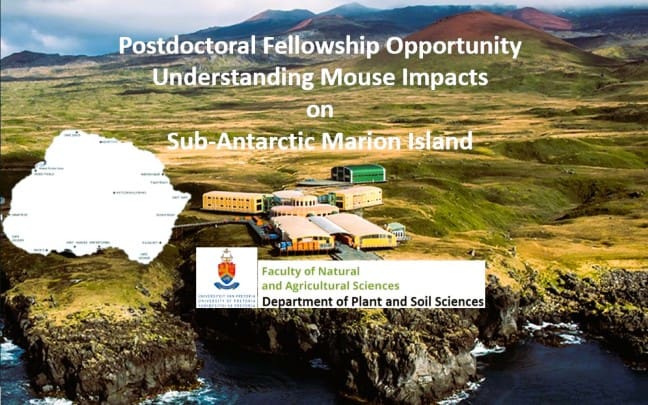
 Postdoctoral Fellowship: Understanding Mouse Impacts on Sub-Antarctic Marion Island at Department of Plant and Soil Sciences, University of Pretoria. (image: Otto Whitehead)
Postdoctoral Fellowship: Understanding Mouse Impacts on Sub-Antarctic Marion Island at Department of Plant and Soil Sciences, University of Pretoria. (image: Otto Whitehead)
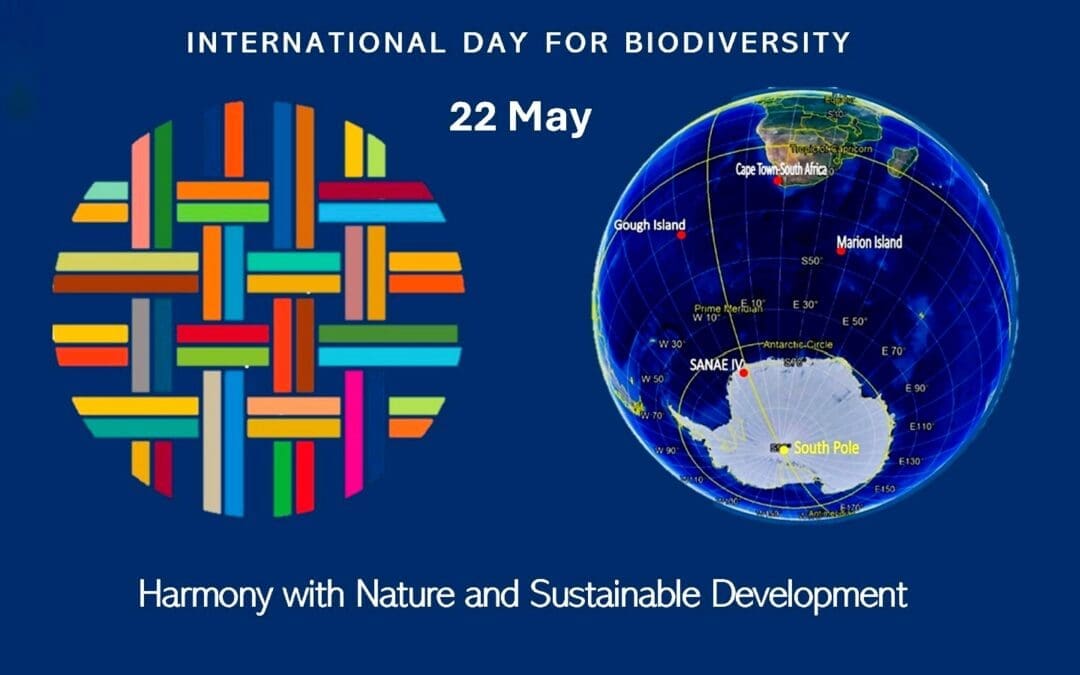
 The United Nations has designated May 22 as the International Day for Biological Diversity (IDB), a day to reflect on the vital role biodiversity plays in sustaining life on Earth. The 2025 theme, “Harmony with Nature and Sustainable Development,” underscores the importance of conserving biodiversity to ensure a sustainable future for both people and the planet. It is a timely reminder that a thriving natural world is the foundation of human well-being and a cornerstone for achieving the Sustainable Development Goals.
The United Nations has designated May 22 as the International Day for Biological Diversity (IDB), a day to reflect on the vital role biodiversity plays in sustaining life on Earth. The 2025 theme, “Harmony with Nature and Sustainable Development,” underscores the importance of conserving biodiversity to ensure a sustainable future for both people and the planet. It is a timely reminder that a thriving natural world is the foundation of human well-being and a cornerstone for achieving the Sustainable Development Goals. In South Africa, this day holds special meaning for the South African National Antarctic Programme (SANAP). Operating across three key research stations — Antarctica, Marion Island (part of the Prince Edward Islands), and Gough Island — SANAP plays a crucial role in understanding and preserving the unique biodiversity of the sub-Antarctic and Antarctic regions. These remote and fragile ecosystems are home to countless species, many of which are found nowhere else on Earth.
In South Africa, this day holds special meaning for the South African National Antarctic Programme (SANAP). Operating across three key research stations — Antarctica, Marion Island (part of the Prince Edward Islands), and Gough Island — SANAP plays a crucial role in understanding and preserving the unique biodiversity of the sub-Antarctic and Antarctic regions. These remote and fragile ecosystems are home to countless species, many of which are found nowhere else on Earth. For decades, SANAP-supported scientists have been at the forefront of biodiversity research in these regions. Their work includes long-term monitoring of bird and marine mammal populations, studies on invasive species, climate change impacts, and ecosystem dynamics. Through rigorous field research and environmental stewardship, SANAP contributes to global knowledge and conservation efforts, ensuring these pristine environments continue to thrive for generations to come.
For decades, SANAP-supported scientists have been at the forefront of biodiversity research in these regions. Their work includes long-term monitoring of bird and marine mammal populations, studies on invasive species, climate change impacts, and ecosystem dynamics. Through rigorous field research and environmental stewardship, SANAP contributes to global knowledge and conservation efforts, ensuring these pristine environments continue to thrive for generations to come. On this International Day for Biological Diversity, SANAP reaffirms its commitment to protecting the biodiversity of the Southern Ocean and its islands — not only for their intrinsic value but also for the essential role they play in the global ecosystem.
On this International Day for Biological Diversity, SANAP reaffirms its commitment to protecting the biodiversity of the Southern Ocean and its islands — not only for their intrinsic value but also for the essential role they play in the global ecosystem.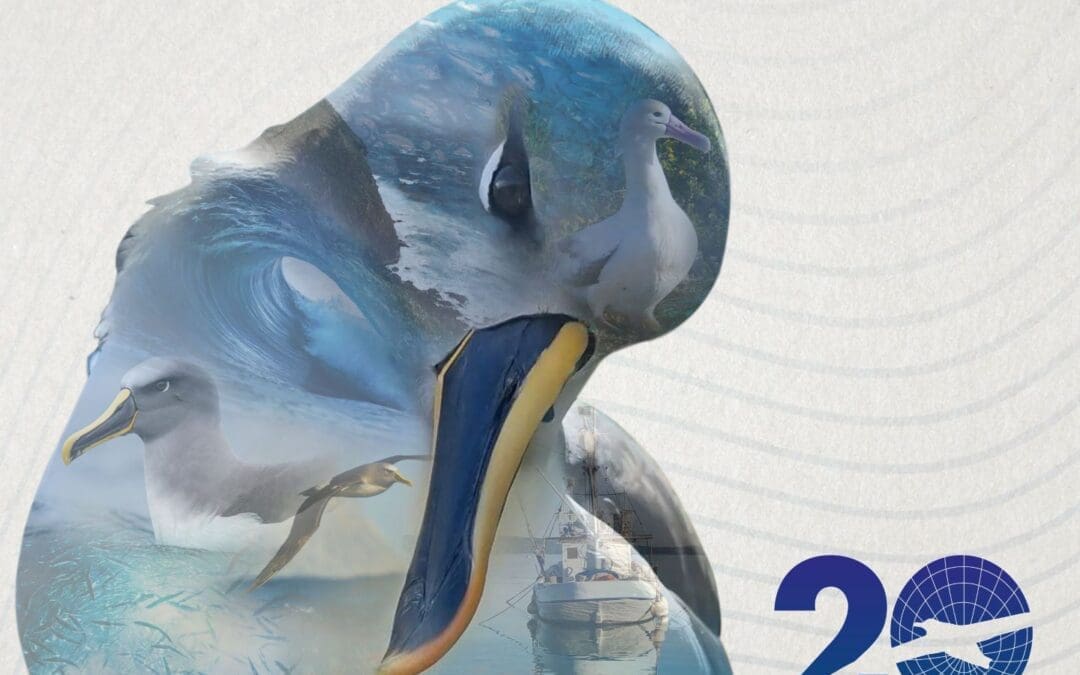
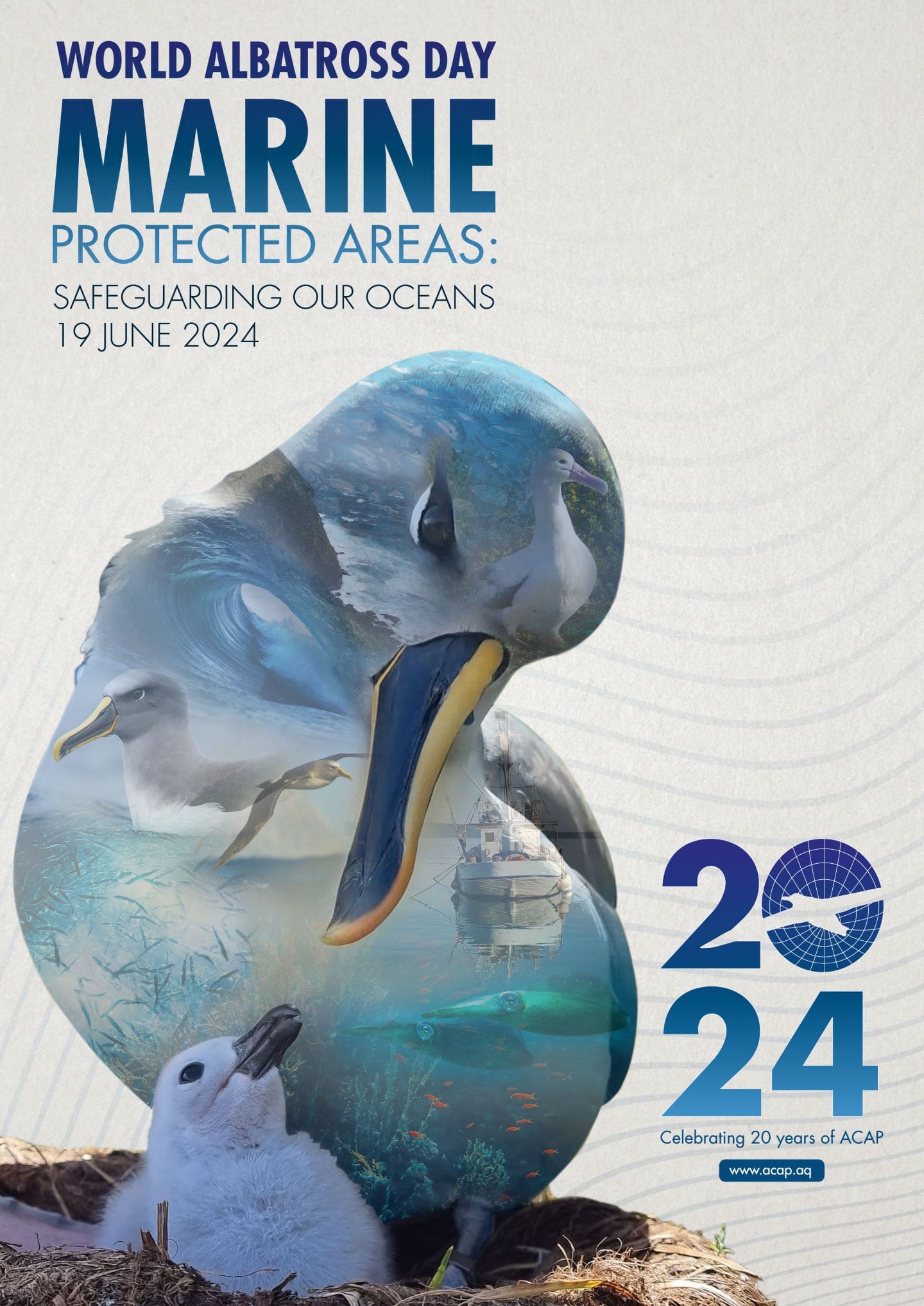 The Agreement on the Conservation of Albatrosses and Petrels (ACAP) has announced that “Marine Protected Areas – Safeguarding our Oceans” is to be its theme for this year’s
The Agreement on the Conservation of Albatrosses and Petrels (ACAP) has announced that “Marine Protected Areas – Safeguarding our Oceans” is to be its theme for this year’s 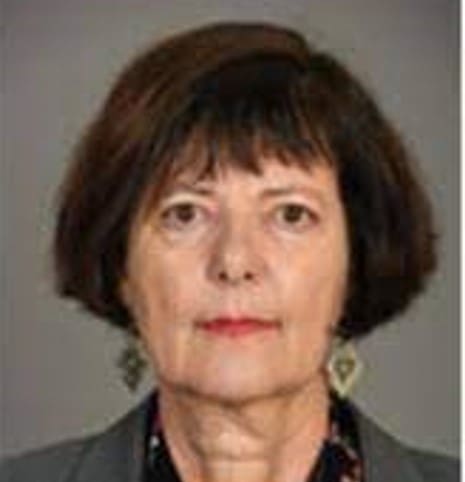
 MINISTER CREECY LAUNCHES THE 3RD NATIONAL STATUS OF BIOLOGICAL INVASIONS AND THEIR MANAGEMENT IN SOUTH AFRICA
MINISTER CREECY LAUNCHES THE 3RD NATIONAL STATUS OF BIOLOGICAL INVASIONS AND THEIR MANAGEMENT IN SOUTH AFRICA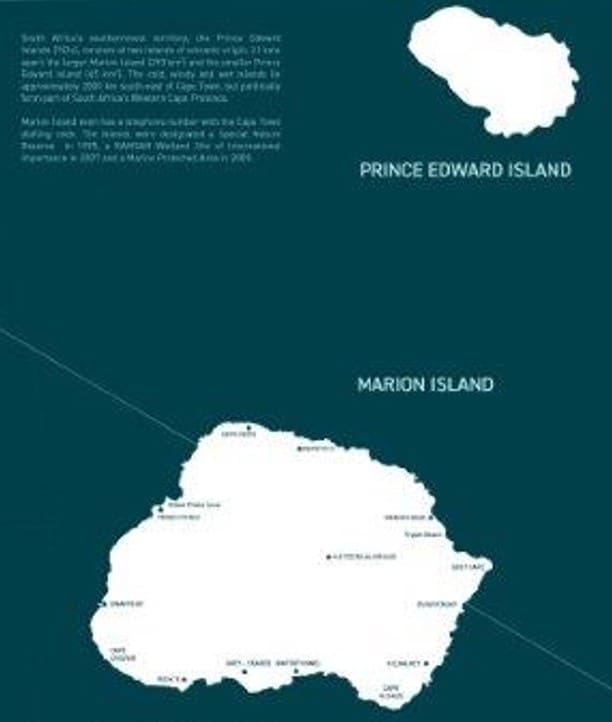 Thirdly, invasive species are devastating the unique and sensitive biodiversity of the Prince Edward Islands. For the first time, this report provides a separate assessment of the status of biological invasions and their management on the Prince Edward Islands. Although these islands are part of South Africa, their remote location and unique biodiversity warrant a separate assessment. Findings highlight the devastating impact of the house mouse, which is alien to the Marion Island. The mice feed on plants, and small animals including endangered seabirds. A bold plan to eradicate mice from the island has been developed and is due to be implemented in 2027. The eradication of mice from Marion Island is essential if its unique biodiversity is to be preserved.
Thirdly, invasive species are devastating the unique and sensitive biodiversity of the Prince Edward Islands. For the first time, this report provides a separate assessment of the status of biological invasions and their management on the Prince Edward Islands. Although these islands are part of South Africa, their remote location and unique biodiversity warrant a separate assessment. Findings highlight the devastating impact of the house mouse, which is alien to the Marion Island. The mice feed on plants, and small animals including endangered seabirds. A bold plan to eradicate mice from the island has been developed and is due to be implemented in 2027. The eradication of mice from Marion Island is essential if its unique biodiversity is to be preserved.
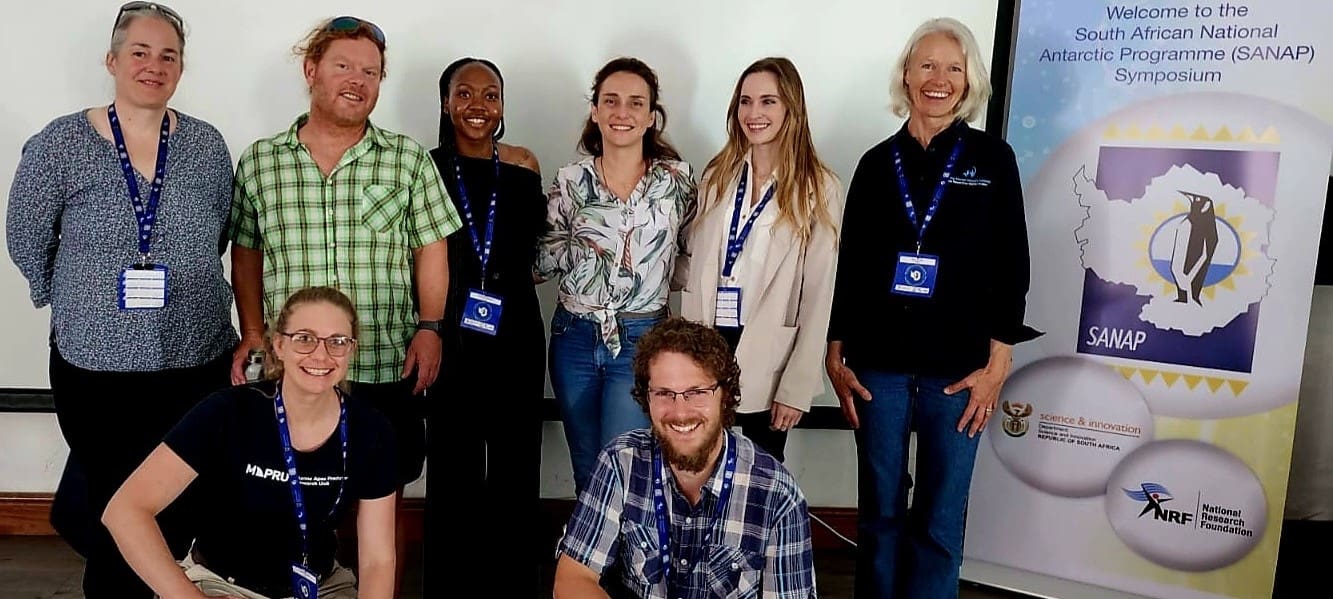
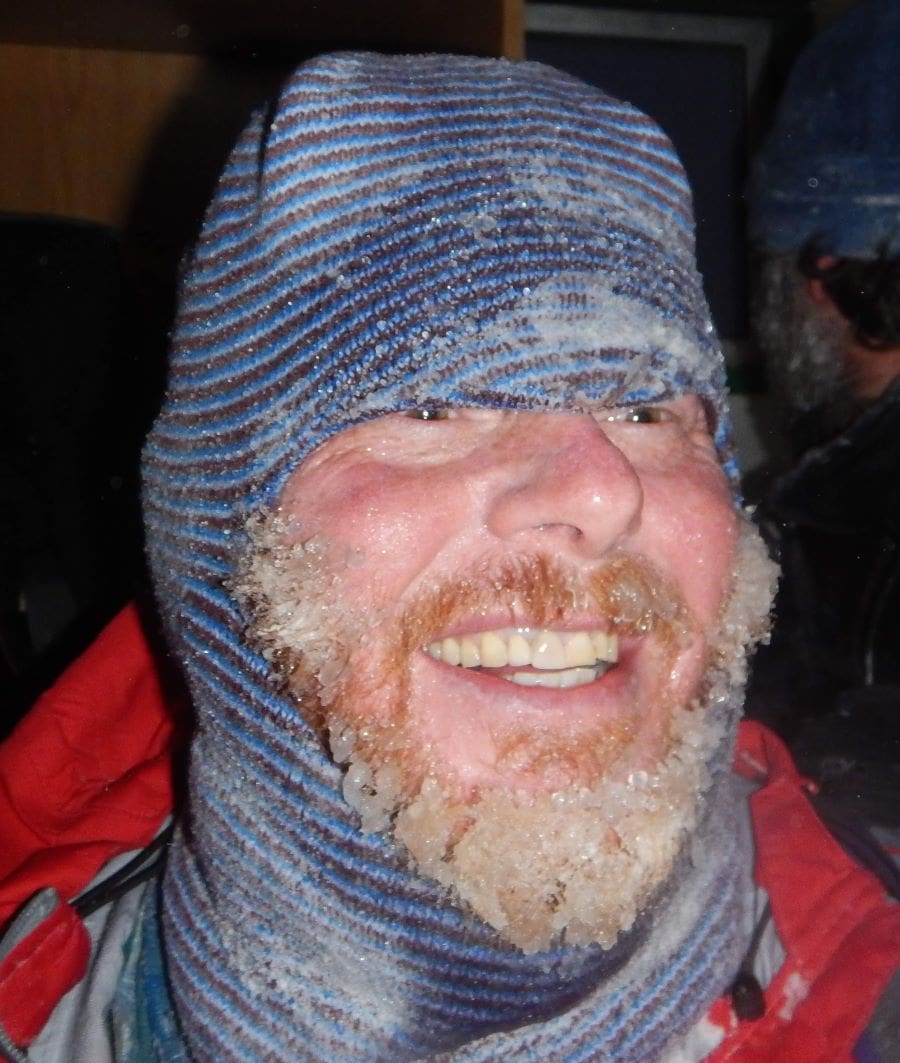
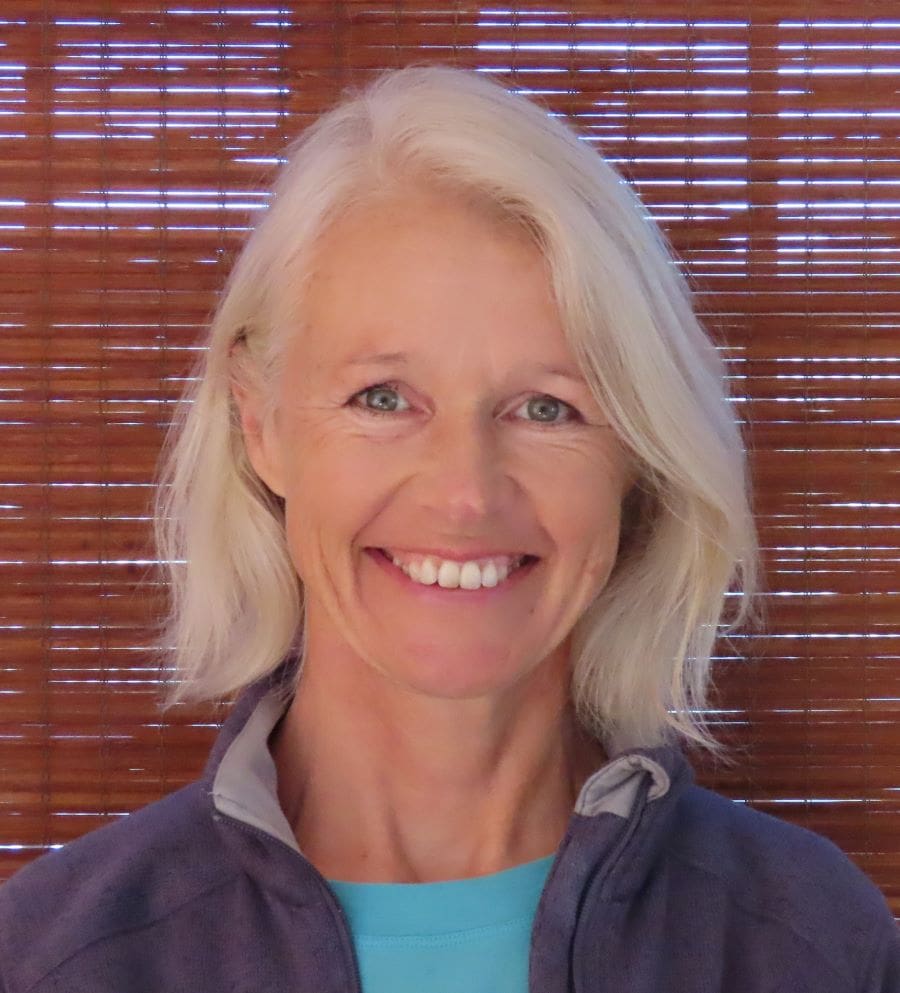 The last session within the
The last session within the  Above (l-r): Vonica Perold, Tegan Walker, Shamiso Banda, Danielle Keys, Eleanor Weideman
Above (l-r): Vonica Perold, Tegan Walker, Shamiso Banda, Danielle Keys, Eleanor Weideman To make your sponsorship to Mouse-Free Marion go to
To make your sponsorship to Mouse-Free Marion go to 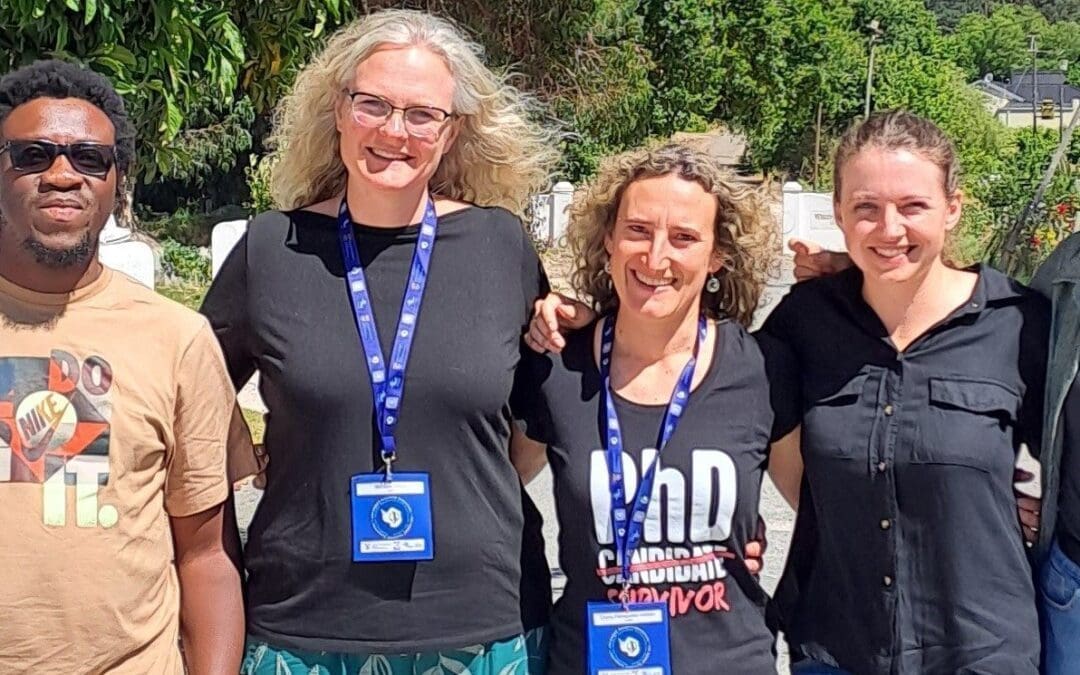
 Michelle Greve chaired another session on Ecosystems “Major threats to terrestrial sub-Antarctic ecosystems – climate change and invasions” , including how climate and species interactions are driving leaf endophyte communities, how warming directly, and indirectly (through heightened microbial decomposition and nutrient release) affects plant performance) affect plant growth, and how vegetation communities on Marion Island have changed since the 1960s on a warmer, drier and more invaded Marion Island. The session ended with a summary of the knowledge garnered from the National Status Report on Invasions, which includes a chapter on the Prince Edward Islands, and summarised all we know about invasions to the offshore territory.
Michelle Greve chaired another session on Ecosystems “Major threats to terrestrial sub-Antarctic ecosystems – climate change and invasions” , including how climate and species interactions are driving leaf endophyte communities, how warming directly, and indirectly (through heightened microbial decomposition and nutrient release) affects plant performance) affect plant growth, and how vegetation communities on Marion Island have changed since the 1960s on a warmer, drier and more invaded Marion Island. The session ended with a summary of the knowledge garnered from the National Status Report on Invasions, which includes a chapter on the Prince Edward Islands, and summarised all we know about invasions to the offshore territory. 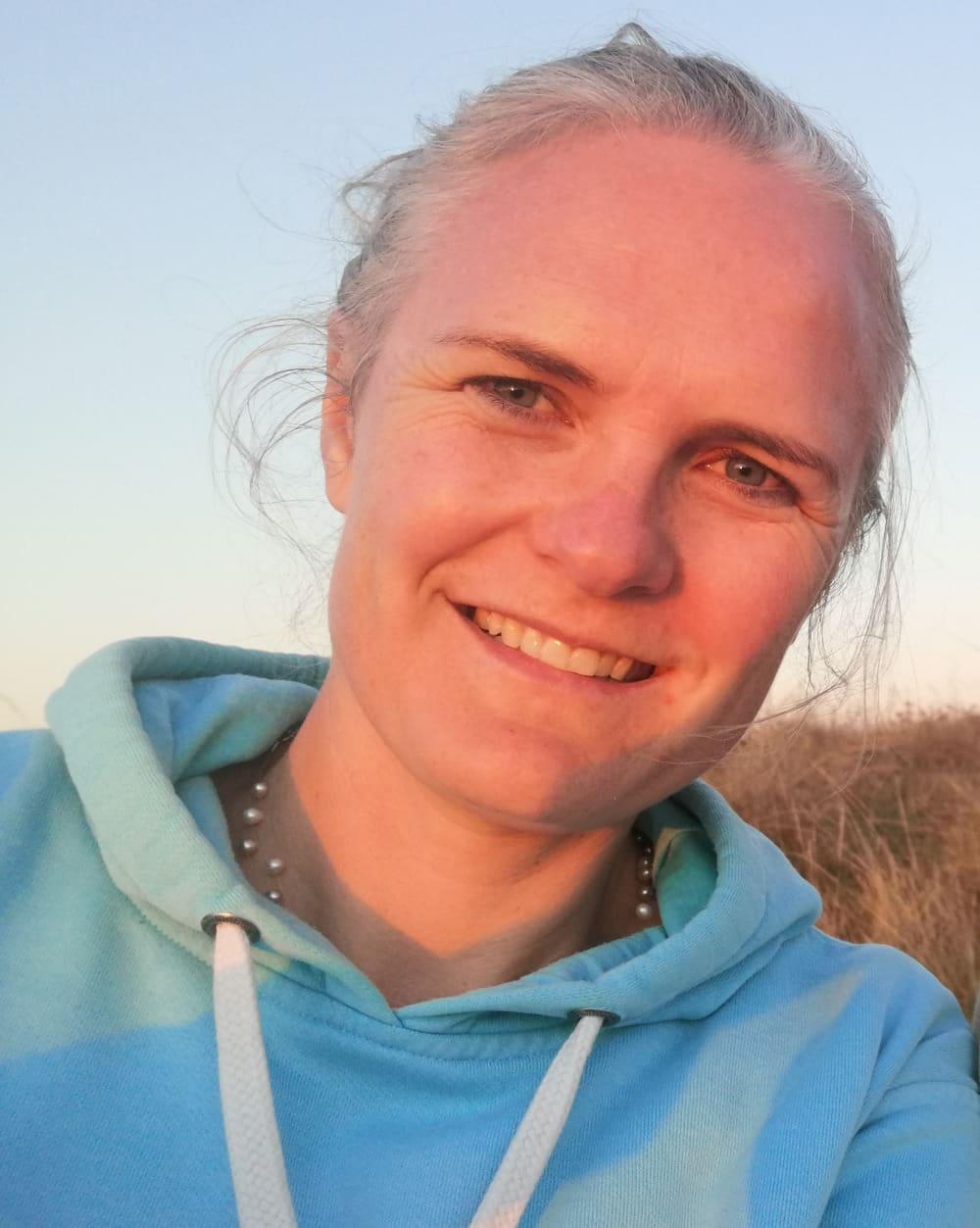 Michelle(right) gave an introduction and then was followed by oral presentations. (Above, l-r: Joshua Tsamba, Michelle Greve, Laura Fernadez-Winzer, Stephni van der Merwe, Nita Pallett) (Photo Credit: Michelle Greve)
Michelle(right) gave an introduction and then was followed by oral presentations. (Above, l-r: Joshua Tsamba, Michelle Greve, Laura Fernadez-Winzer, Stephni van der Merwe, Nita Pallett) (Photo Credit: Michelle Greve) Another student Janine Schoombie of Peter le Roux of University of Pretoria presented in the ad hoc session chaired by Christel Hansen. They only arrived on 30 November after the Prince Edward Island scientific voyage. “Studies of wind, plants and seabirds on Marion Island”. (
Another student Janine Schoombie of Peter le Roux of University of Pretoria presented in the ad hoc session chaired by Christel Hansen. They only arrived on 30 November after the Prince Edward Island scientific voyage. “Studies of wind, plants and seabirds on Marion Island”. (


